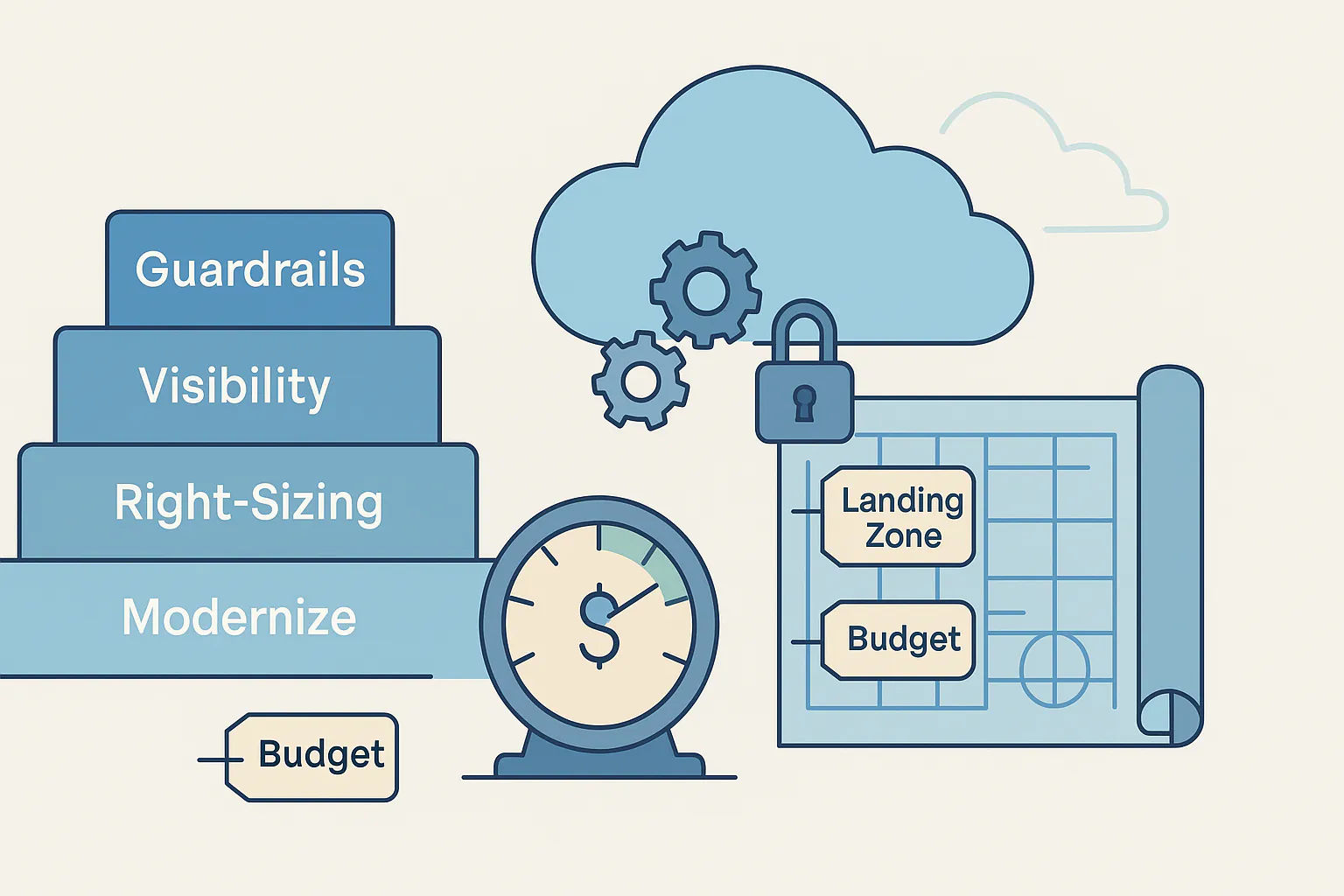Cloud Cost Management Solutions You Can Run This Quarter
Key Takeaways
- Cloud Cost Management Solutions work best with budgets, tags, and policy baked into landing zones.
- A steady loop of visibility, right sizing, scheduling, and modernization keeps spend predictable as you scale.
- A simple 30-60-90 plan stabilizes costs, shrinks big spenders, and makes savings durable with autoscale and reserved capacity.

Your cloud bill should read like a plan, not a surprise. If costs feel slippery, this guide gives you a clear way to regain control: what to measure, how to right-size, and where governance tools fit. You will see simple steps you can run this quarter and longer-horizon moves that keep spend predictable as you scale.
Yocum Technology Group helps teams move and modernize on Azure with wave-based plans, landing zones, and budget guardrails so performance and costs stay on track during and after migration.
What You Will Learn
- A five-layer model for cloud cost management you can apply on Azure right away.
- How to build budget guardrails into landing zones so costs are capped, not guessed.
- Practical optimization moves for compute, storage, data, and networking.
- The role of modernization during migration, and why cost control is stronger when you refactor toward managed services and CI/CD.
- How YTG structures cloud work so spend, security, and speed move together.
First Principles: What “Cloud Cost Management Solutions” Cover
Cloud cost management solutions blend governance, measurement, and engineering choices that reduce unnecessary spend without sacrificing reliability or speed. For Azure teams, that means:
- Guardrails from day one: budgets, tagging, role boundaries, and policy baked into landing zones.
- Right-sizing routinely: matching SKUs to real usage, not last month’s guess.
- Modernization as a cost lever: moving to managed services and automating release pipelines to shrink infrastructure overhead.
- Transparent reporting: normalized tagging and chargeback/showback so finance and engineering see the same picture.
This is not just cost-cutting. It is cost visibility plus cost design—keeping spend predictable as you ship.
The Five-Layer Model For Cloud Spend Control
Think of cost control in five stacked layers. Each layer is a clear set of actions. Work top-down to prevent waste, then bottom-up to tune workloads.
1) Organizational Guardrails
Goal: establish budgets, tags, and policies so costs are controlled before resources exist.
- Landing zones with budgets: place workloads into prepared subscriptions or resource groups that carry budget limits and alert thresholds. YTG implements landing zones to keep risk low and momentum high during migration, which is the right moment to embed budgets.
- Tagging schema: standard tags like
Owner,App,Environment,CostCenter. Without this, reports are noise. - Policy-as-code: restrict high-cost SKUs, enforce regions, and require tags at creation.
Quick check. If you cannot answer “who owns that $2,300/month resource,” your tags are missing or inconsistent.
2) Visibility And Allocation
Goal: turn raw billing into useful reports.
- Perspective by app and environment: show dev/test/prod separately.
- Showback and chargeback: business units see their spend; teams learn to size thoughtfully.
- Unit economics: cost per active user, per order, per GB processed. When cost ties to a business metric, prioritization gets easy.
3) Right-Sizing And Scheduling
Goal: match capacity to demand.
- Rightsize compute: choose VM sizes or service tiers based on observed CPU, memory, and IO patterns, not gut feeling.
- Autoscale where possible: scale out on load and scale in when quiet.
- Stop the idle: dev/test environments should not run 24/7. Schedule them off nights and weekends.
- Commitment discounts: evaluate reserved capacity or savings constructs for steady workloads.
4) Modernization As A Cost Lever
Goal: lower the total cost of ownership by reducing operational toil.
- Use managed services: moving from self-managed databases and queues to Azure managed services trims patching and ops overhead. YTG modernizes during migration so you get performance gains and cleaner code while costs are planned upfront.
- CI/CD and automated testing: faster, safer releases mean fewer long-running parallel environments and less rework. YTG highlights CI and automated testing during cloud moves for this reason.
- Refactor hotspots: split or cache heavy endpoints, shift batch jobs to scheduled or event-driven functions, and archive cold data.
5) Continuous FinOps Loop
Goal: never let drift sneak back in.
- Monthly spend reviews: compare forecast vs. actual, call out anomalies, and log actions.
- Alerts on cost and usage: treat runaway spend like an incident.
- Quarterly architecture tune-ups: re-evaluate storage tiers, network egress, and dependency latency.
Where To Start: A 30-, 60-, 90-Day Plan
Days 0–30: Stabilize And See
- Standardize tags across all subscriptions.
- Create or refine landing zones with budgets and alerts.
- Stand up a single spend dashboard grouped by app and environment.
- Turn on idle shutdown schedules for non-prod.
Days 31–60: Shrink The Big Rocks
- Rightsize the top 10 most expensive compute resources.
- Tier storage: move old blobs to cooler tiers and implement lifecycle rules.
- Cut noisy egress: review cross-region traffic, CDNs, and chatty microservices.
Days 61–90: Make It Durable
- Autoscale high-variance services.
- Adopt reserved capacity or other savings options on stable workloads.
- Plan a modernization sprint: migrate one self-hosted component to a managed service and wire it into CI/CD.
Deep Cuts: Tactics That Quietly Save Thousands
Compute
- Pick the right tier: avoid over-provisioned VMs and database SKUs.
- Stateless first: scaling stateless services is cheaper and simpler; push state into managed backends.
- Ephemeral build agents: spin up on demand during CI, tear down immediately.
Storage
- Lifecycle + versioning: keep current data hot, archive what’s cold, and purge versions on a schedule.
- Compression and format: columnar formats for analytics, compressed logs with expiration.
- Object vs. block vs. file: pick the cheapest that fits access patterns.
Data And Analytics
- Right-size compute pools in your analytics service.
- Partitioning and caching: warm caches reduce repeat reads and expensive scans.
- Batch wisely: small frequent jobs can be more costly than a planned window.
Networking
- Keep data close: cross-region and cross-cloud traffic adds up.
- CDN correctly: cache static assets and large downloads near users.
- Private links: sometimes cost less than public egress plus security tooling.
Observability
- Sampled logs where full fidelity is not required.
- Shorter retention for high-volume noise, long retention for audit trails only.
- Trace budgets: instrument only what helps decisions.
Cloud Cost Analysis: Turning Billing Data Into Decisions
A cloud cost analysis is more than a report. It is a short feedback loop:
- Ingest and group by tags.
- Rank by opportunity: top 20 resources by monthly cost and by waste risk (idle, over-provisioned, high egress).
- Propose changes: size drops, schedule changes, tier moves.
- Simulate the new monthly total.
- Apply and monitor for two weeks.
Teams that run this loop monthly cut spend and keep performance steady because the same data feeds both.
Cloud Expense Management: Showback Without The Drama
Finance wants predictability. Engineering wants freedom. The answer is showback:
- Budgets at app level: not just global caps.
- Forecasting: extrapolate from last 30 days with known changes.
- Alerts that matter: owner gets pinged when their app burns through 75 percent of the monthly budget.
- No surprises: new resources are created only in landing zones where budgets and policies are already set. YTG’s approach embeds these guardrails during migration so teams start in a safe baseline.
Cloud Optimization Services: When To Bring In Help
Outside help speeds up two moments:
- During migration: to design landing zones, plan waves, and modernize parts of the stack without pausing delivery. This is a YTG focus area, with an emphasis on risk-controlled moves and cost planning up front.
- After migration: to institutionalize the FinOps loop, formalize budgets, and harden CI/CD so cost control is routine.
YTG’s broader software practice—custom apps, Azure-aligned cloud solutions, and modernization—means cost work stays aligned with how your systems are actually built and shipped.
Cloud Cost Management Tools: Picking What Helps, Skipping What Doesn’t
Tools do not solve tagging, and they cannot right-size code. Choose tools that:
- Integrate with budgets and policy in your landing zones.
- Support unit economics: cost per user or order, not just per VM.
- Surface anomalies quickly: yesterday’s spike should be visible today, not at month-end.
You can add third-party layers later. Start with the platform’s own cost views to validate tags and owners, then expand if you need richer allocations.
Cloud Optimization Implementation: Make It A Habit
Treat optimization like SRE:
- Create tickets for every optimization with an owner, a date, and an expected monthly delta.
- Review deltas after 30 days to learn which tactics pay off.
- Add checks to CI: block deployments that create untagged resources or forbidden SKUs.
- Publish a one-page standard for app teams: tagging rules, start/stop schedules, approved SKUs, storage tiers.
Cost Management During Cloud Migration
Migration is the perfect time to bake in cost control because you are already touching every workload.
- Wave-based planning: group apps by dependency and risk, so you can clean up resources and modernize as you go.
- Landing zones first: deploy networks, identity, budgets, and policies before the first app moves.
- Modernize in motion: adopt Azure managed services and automated testing while migrating to trim fragile code and reduce ops overhead.
YTG’s migration and modernization services are structured around these steps to keep performance up and spend predictable during change.
Real-World Cost Traps And How To Avoid Them
- Over-provisioned dev/test: set schedules on day one.
- Tiny services with heavy chat: network egress can exceed compute. Consolidate chatty components or co-locate.
- Over-retained logs: define retention by data class, not by habit.
- “Temporary” experiments: enforce a 30-day review for any resource tagged
Experimental=true. - Copy/paste SKU upgrades: before bumping a tier, profile the bottleneck. Sometimes caching or a single query fix avoids a bigger bill.
Governance That Does Not Slow You Down
Good guardrails speed teams up because the safe path is the easy path.
- Templates for new apps: resource groups arrive with budgets, tags, and alerts.
- Role scoping: devs can create within their zone; cross-cutting changes go through review.
- Exception process: a lightweight approval for experiments above a certain cost.
YTG emphasizes design up front—landing zones, policies, and budget guardrails—so engineering does not fight governance later.
Where YTG Fits
- Cloud migration and modernization with risk-controlled waves, landing zones, and modernization during the move.
- Azure-aligned cloud solutions that improve performance and cost efficiency, integrating CI and testing for steady release pace.
- Strategic guidance rooted in software delivery, so cost controls tie to real workflows rather than abstract policies.
If you are planning a migration, or you migrated but costs drifted, YTG can tune your landing zones, set budgets, and help right-size the top spenders while building a monthly FinOps loop around your apps.
Key Takeaways
- Build guardrails into landing zones and you will prevent waste before it starts.
- Run a monthly cost analysis loop with tags, top-spender reviews, and tracked deltas.
- Treat modernization as a cost tool: managed services and CI/CD cut overhead.
- Use tools to enforce budgets, alerts, and allocation, then right-size based on observed usage.
- During migration, wave plans and modernization in motion keep performance up and spend predictable.
Next Steps
- Tag everything and enable budgets inside landing zones.
- Build one spend dashboard grouped by app and environment.
- Rightsize the top 10 resources and turn on dev/test schedules.
- Pick one component to modernize to a managed service and connect it to CI/CD.
- If you want a fast start, bring in YTG to structure the plan and help your teams ship while spending less.




